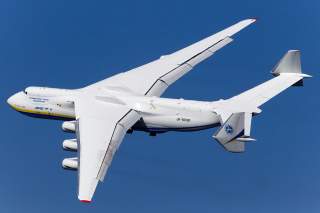Russia’s AN-225: The World’s Biggest Aircraft – Or White Elephant?
In mankind’s perpetual obsession with the idea that bigger is better, the Soviet Union was tops. Case in point: the AN-225 Mryia, the world’s biggest cargo jet.
In mankind’s perpetual obsession with the idea that bigger is better, the Soviet Union was tops.
Case in point: the AN-225 Mryia, the world’s biggest cargo jet. Only one Mriya (Ukrainian for “dream”) was ever built by the Soviet Union, while a second rests unfinished in a Ukrainian warehouse, possibly to be flown by China.
The specifications of this load-bearing monster are impressive. The six-engined Mryia is 275 feet long and 59 feet high, with a wingspan of 290 feet (the legendary Boeing 747-8 has a wingspan of only 224 feet, while the U.S Air Force’s giant C-5 Galaxy had a wingspan of 223 feet). Weighing in 314 tons empty and with a maximum takeoff weight of 640 tons, it can carry 250 tons of cargo and has a maximum range of 10,000 miles. With a maximum speed of 530 miles per hour, it is a relatively fast aircraft.
From Howard Hughes’ Spruce Goose to the XB-70 Valkyrie bomber, the fate of giant airplanes has often been less than happy. The AN-225 is no exception. It was conceived as a weapon of the Space Race, a flying mule for the Soviet Union’s Buran space shuttle. just like NASA’s modified 747 airliner that ferried America’s Space Shuttle piggybacked on the roof.
To the credit of the Antonov Design Bureau – that stalwart builder of many Russian transport planes -- it managed to build the flying giant in just three years from conception to takeoff. In December 1988, the AN-225 first took flight. And it did accomplish its mission on at least one occasion, carrying a Buran to the Baikonur spaceport.
“Because of its size, pilots need special training to cope with the challenges of maneuvering the An-225,” noted a CNN article. “One of the airplane's quirks is its ability to perform a so-called ‘elephant dance,’ a term used in aviation when the nose gear "kneels" to make cargo loading easier.”
The Soviet Union planned to build three more AN-225s, and indeed, production began of a second Mriya in 1989. But those plans ended with the collapse of the Soviet Union in 1991, leaving just one partially-built AN-225 in a Ukrainian hangar.
This left the sole flyable AN-225 to serve both as a workhorse and curiosity piece. Bearing the aura of being the world’s largest plane made the Mryia a favorite at airshows. But it also has been a legitimate cargo jet flying under the auspices of Ukraine’s Antonov Airlines in the post-Soviet era. The AN-225 gets called in for special cargos, such as hauling giant generators and wind turbines (it has also hauled four main battle tanks in a single flight).
The aviation world has been abuzz in recent years with reports that China had expressed interest in completing the second AN-225, which is estimated to be 70 percent complete. “Rumors were rife then that the state-owned giant would resurrect the An-225 program with a Chinese touch, including improvements to its landing gear and avionics to serve the Chinese military, as well as an air-launch platform for commercial satellites,” according to a 2019 Asia Times article.
Nonetheless, it is difficult to see a bright future for the Mryia. The trend in aviation today is for fuel-efficient passenger and cargo jets that can operate cheaply. While one – or perhaps two – AN-225s might be useful for specialized cargo that can’t be hauled by other aircraft, a 1980s design is unlikely to be revived.
Michael Peck is a contributing writer for the National Interest. He can be found on Twitter and Facebook.

